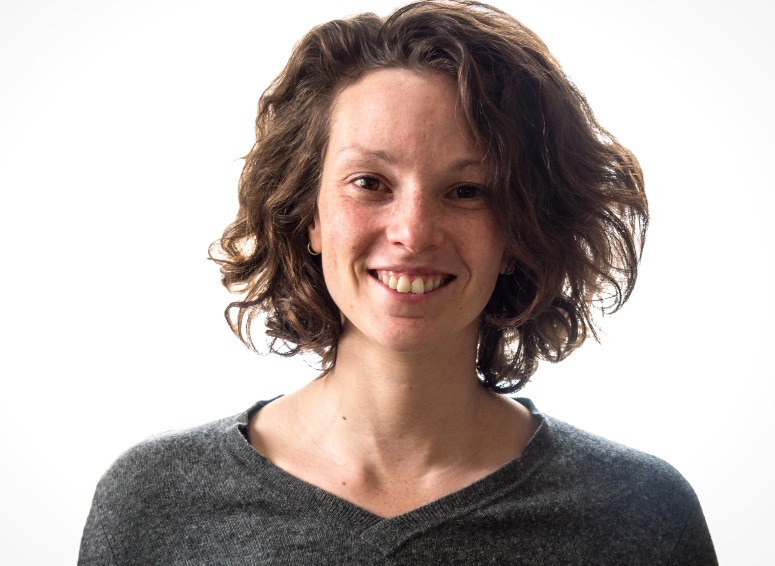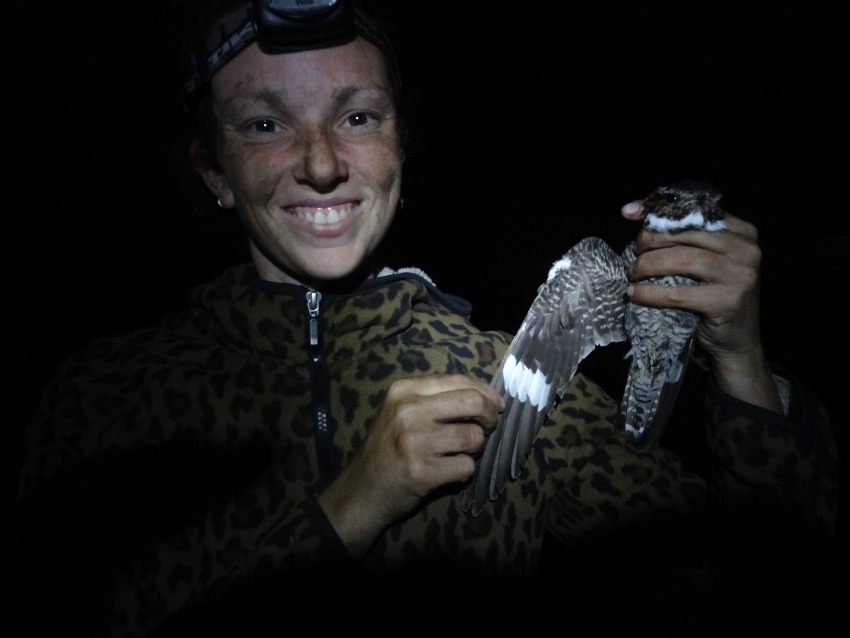Dr. Elly Knight is the ABMI’s new Statistical Ecologist and resident bird expert. Elly is also much more than that. She’s an ornithologist, research scientist, data lover, advocate for the Common Nighthawk, citizen science pioneer, storyteller, and mother, to name a few. Today is International Women’s Day, and we celebrate the over 40 unique women who work at the ABMI, who like Elly, play many important roles and contribute to our mission to track and tell the data-driven stories of Alberta’s ecosystems and wildlife.
Elly has had a prolific career as a research scientist with over a decade of experience collecting, studying and interpreting bird data in British Columbia, Alberta, and the United States. I had a conversation with Elly about her experiences and challenges as a female scientist, researcher, and mother. What stands out most of all is her joy for continual learning and discovery, her demonstrated commitment to collaboration and community, and her determination to share fundamental data and untold stories of Nightjars (the nocturnal family of birds that Common Nighthawks belong to), and other bird species in Alberta’s ecosystems.
Tell us about your work at the ABMI.
I’m so excited to work at the ABMI on diverse and valuable projects. I worked with the ABMI during my PhD, so it’s a wonderful opportunity for me to continue collaborating with some great people. I’ll be continuing the important work of implementing provincial bird products and interpreting those products from an avian ecology perspective. My focus will also be on integrating Autonomous Recording Units (ARUs) and computer automation processes. I find a lot of joy in my work, especially in research, data and the quantitative aspects. I’m currently also completing my Postdoctoral Fellowship working with Dr. Autumn-Lynn Harrison at the Smithsonian Migratory Bird Center.
What was your path to becoming an ecologist?
My dad has been an ecologist in British Columbia for over 35 years and I’ve learned a great deal from his hands-on approach. I did undergraduate work at the University of Victoria and my Masters in British Columbia at Simon Fraser University. I developed a broad skill set in ornithology, which meant spending every season in the field. I did my PhD in Nightjar ecology with Dr. Erin Bayne at the University of Alberta, developing methods of data collection for the Common Nighthawk with passive acoustic monitoring ecology.
If you want to be a mother and work in science, then go out and do it. It’s possible to do both, you shouldn’t have to choose between one or the other. You can find a community to support you.
You have pioneered the study and collection of data on the Common Nighthawk. What makes Nighthawks so interesting for you?
I became fascinated by Nighthawks while I was working in the field in the south Okanagan of British Columbia. In the sagebrush you often just kind of stumble upon their nests and eggs. They are elusive with a distinctive call, and just very unique, we actually don’t know much about them. They are currently listed as Threatened by COSEWIC [under review] and I realized this was an opportunity to understand them better.
The wildlife management community had very little data on Nighthawks, so I developed a citizen science survey program to collect more information. Part of the idea was to provide graduate students with data and projects to work with for further study. I received encouragement to take this further and try different things so after thousands of hours of work and collaborations, we evaluated how important the survey was for managing Common Nighthawks. Our research showed that this data is really fundamental to monitoring Nightjar populations and understanding their habitat requirements. The research also encouraged Environment and Climate Change Canada (ECCC) to provide long-term support for the nightjar survey, which is now run by the citizen science experts at Birds Canada.
What did you learn?
I learned so much about myself, the value of natural history and the value of listening and consulting with Indigenous peoples and landowners. It comes down to the power of the community and the determination to make this project happen. I learned about developing and evaluating monitoring protocols, how valuable that is and how it is so important how data gets collected and used.
What other projects are you most proud of?
I am also very proud of my work on a large scale movement tracking project with the Smithsonian Migratory Bird Center, ECCC, and a variety of other partners. We deployed GPS trackers of individual Common Nighthawks at 13 locations across North America to understand where and when they go during their full annual cycle. What I learned most from this project is the importance of reaching out and collaborating. I feel that planning, clear direction, and communication of expectations are fundamental to success.

Photo: Jonathan DeMoor
What inspires you and your work?
The beauty of ecosystems and the beauty of its complexity. Even if it’s just getting a peek behind the data, it gives you so much. I subscribe to the idea of data presents. It’s the concept that you know you are a scientist when looking at data is like opening a present and you feel the same excitement that you felt as a child. It’s a joyful process and so fun to learn. It’s the ability to see things that no one has seen before; finding the trends, and embedding that into an ecological story.
What professional challenges have you encountered as a female scientist?
I would say the physical aspect of field work can be hard, not because I am not fit or strong, but just because I’m physically smaller. I’ve been encouraged to be confident in who I am and share that. I’ve not felt talked down to. However, I have worked in situations where I was the only woman, especially in the areas of data automation and processing.
By far, the biggest challenge has been having a child [Elly is a proud mother to a two-year old daughter as well as two stepkids, 10 and 13], and there is gender disparity in that experience. The hormonal, cognitive and physical aspects of giving birth and being a mother are very challenging. It changes who you are and it takes adjustment to balance the roles of mother and doing high-level cognitive work. I understand why there is a glass ceiling and the potential inequity that can come with mothering a child.
What changes would you like to see in support for women in science?
I would like to see the breaking down of barriers for women in the workplace in terms of integrating family life. That could mean bringing children to conferences and the workplace.
The great thing about the pandemic and working from home has been that colleagues get to see the reality of family life and there is value in colleagues seeing that. Encouraging support from male colleagues, the community and garnering more empathy would do a lot. I gave birth to my daughter during my PhD, which did not offer maternity leave, so having that community support is crucial.
What advice would you give to a young woman interested in a career in science?
Do your best to move past imposter syndrome. Your ideas matter and you have the right to share your thoughts. One of the best gifts I received was from Dr. Erin Bayne. He told me to just be myself, and that who I am is an asset to my work as a scientist. So, you can be a scientist and also be yourself, those things are inseparable, and there is no need to keep those parts separated and in silos as scientists often do. As a woman of course you can choose to have children or not. If you want to be a mother and work in science, then go out and do it. It’s possible to do both, you shouldn’t have to choose between one or the other. You can find a community to support you.
To learn more about Elly, her work and publications, you can visit her website here.

